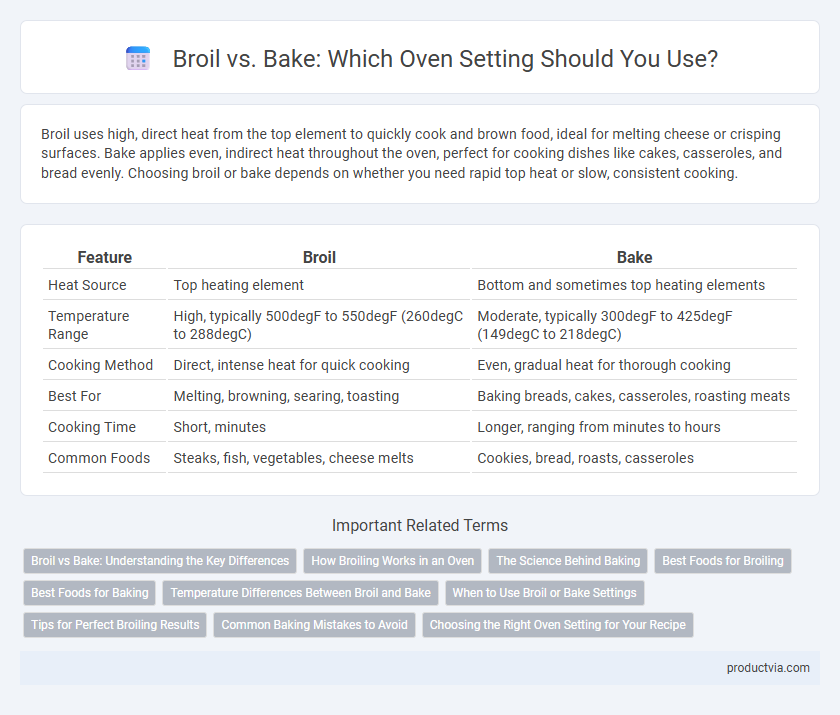Broil uses high, direct heat from the top element to quickly cook and brown food, ideal for melting cheese or crisping surfaces. Bake applies even, indirect heat throughout the oven, perfect for cooking dishes like cakes, casseroles, and bread evenly. Choosing broil or bake depends on whether you need rapid top heat or slow, consistent cooking.
Table of Comparison
| Feature | Broil | Bake |
|---|---|---|
| Heat Source | Top heating element | Bottom and sometimes top heating elements |
| Temperature Range | High, typically 500degF to 550degF (260degC to 288degC) | Moderate, typically 300degF to 425degF (149degC to 218degC) |
| Cooking Method | Direct, intense heat for quick cooking | Even, gradual heat for thorough cooking |
| Best For | Melting, browning, searing, toasting | Baking breads, cakes, casseroles, roasting meats |
| Cooking Time | Short, minutes | Longer, ranging from minutes to hours |
| Common Foods | Steaks, fish, vegetables, cheese melts | Cookies, bread, roasts, casseroles |
Broil vs Bake: Understanding the Key Differences
Broil uses intense, direct heat from the oven's top element to quickly cook and brown foods, ideal for melting cheese or crisping surfaces. Bake relies on consistent, surrounding heat at lower temperatures, perfect for evenly cooking bread, cakes, and casseroles. Knowing these differences helps optimize cooking results by selecting broil for high-heat searing and bake for thorough, even cooking.
How Broiling Works in an Oven
Broiling in an oven uses intense, direct radiant heat from the top heating element to cook food quickly, ideal for browning or crisping surfaces. The high temperature typically ranges between 500degF to 550degF, searing the exterior while locking in moisture. This method contrasts with baking, which employs indirect, ambient heat surrounding the food for even cooking throughout.
The Science Behind Baking
Baking uses consistent, ambient heat that surrounds the food, allowing moisture to evaporate gradually and promoting Maillard reactions that develop flavor and texture. TheScienceBehindBaking relies on convection and radiation to cook food evenly, making it ideal for breads, cakes, and casseroles. Broiling applies intense, direct heat from above, rapidly caramelizing the surface but not cooking through evenly as baking does.
Best Foods for Broiling
Broiling is ideal for cooking tender cuts of meat like steaks, pork chops, and fish fillets because it uses intense direct heat from above, creating a crispy, caramelized exterior while keeping the inside juicy. Vegetables such as asparagus, bell peppers, and tomatoes also respond well to broiling, developing a smoky flavor and slightly charred texture. For optimal results, place food closer to the broiler element and monitor closely to prevent burning.
Best Foods for Baking
Baking is ideal for foods that require even, consistent heat such as cakes, bread, casseroles, and cookies, which benefit from the oven's stable temperature and gentle cooking method. Recipes that need moisture retention and thorough cooking, like muffins and roasted vegetables, perform best under the bake setting. Avoid using the broil setting for these items, as its direct high heat can cause uneven cooking or burning.
Temperature Differences Between Broil and Bake
Broil settings in ovens operate at significantly higher temperatures, often reaching 500degF to 550degF, to direct intense, direct heat from the top element for quick cooking and browning. Bake settings maintain lower, consistent temperatures typically between 300degF and 450degF, providing even, indirect heat from both the top and bottom elements to cook food thoroughly. Understanding these temperature differences helps optimize cooking results, with broiling ideal for searing and baking preferred for delicate, evenly cooked dishes.
When to Use Broil or Bake Settings
Broil setting in an oven uses direct, high heat from the top element, ideal for quickly cooking thin cuts of meat, melting cheese, or crisping the surface of dishes. Bake setting provides even, indirect heat surrounding the food, perfect for cooking cakes, bread, casseroles, and any dish requiring thorough, consistent cooking. Choose broil for fast, intense heat on top and bake for slow, uniform cooking throughout the dish.
Tips for Perfect Broiling Results
Broiling uses direct high heat from the oven's top element, ideal for quickly cooking thin cuts of meat, fish, or vegetables with a crispy exterior. To achieve perfect broiling results, position the oven rack 3 to 6 inches from the heating element and preheat the broiler for at least 5 minutes to ensure consistent heat. Use a broiler pan that allows fat to drip away, and monitor food closely to prevent burning, turning as needed for even cooking.
Common Baking Mistakes to Avoid
Using the broil setting instead of bake can cause uneven cooking and burnt tops due to intense direct heat exposure. Baking with incorrect temperature or positioning racks too close to heating elements often leads to undercooked interiors or overbrowned surfaces. Avoiding mistakes like improperly preheating the oven and misusing broil versus bake ensures consistent texture and flavor in recipes.
Choosing the Right Oven Setting for Your Recipe
Broil and bake settings serve distinct purposes in oven cooking based on heat source and temperature. Broil uses direct top heat to quickly brown or crisp food surfaces, ideal for thin cuts, melting cheese, or finishing dishes, while bake applies even, lower heat from both top and bottom elements, suitable for thorough cooking of cakes, casseroles, and bread. Selecting the right oven setting depends on the desired texture and cooking time, ensuring optimal results for specific recipes.
Broil vs Bake for oven settings Infographic

 productvia.com
productvia.com